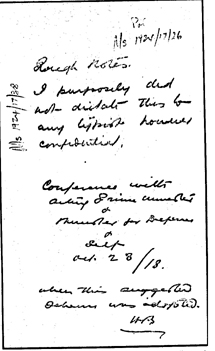
Brookes's"Rough
Note", written in October 1918, recording that his
"suggested scheme" for an Australian Protective
League had been approved and adopted at the highest level
of the Commonwealth Government (the actual head of the
Australian version of the APL was, initially, the Governor-General's
Official Secretary, Sir George Steward)
YET
THERE WAS another, and equally significant ingredient
in the social and political "witches' brew"
that was bubbling up in Sydney just prior to Lawrence's
arrival. This was the role and position of the returned
troops from Europe..."the Diggers".
Today it is difficult to appreciate the influence the
returning servicemen had on politics and social life in
Sydney and Australia in the years after the First World
War. Their presence and activities were an omnipresent
factor in national affairs through the 1920s and into
the 1930s and beyond.
The ex-soldiers - particularly the officer element - were
the heart of soul of the secret army Lawrence stumbled
on in Australia, which was why he called it "the
Diggers movement".
In the chapter Lawrence entitled "Diggers",
Callcott tells Somers:
| "There's
quite a number of us in Sydney - and in the other
towns as well - we're mostly diggers back from the
war - we've joined up into a kind of club - and we're
sworn in - and we're sworn to OBEY the leaders, no
matter what the command, when the time is ready -
and we're sworn to keep silent till then." |
Other
sources (such as the delightfully-named "Secret Bundles"
- classified police files to which I was given special
access by former Bulletin editor Peter Coleman,
then the NSW Chief Secretary) gave a picture of how Callcott's
"kind of club" - the Old Guard - was organised.
In Kangaroo, Lawrence outlines Somers's understanding
of what Callcott - ie, Jack Scott - revealed to
him:
|
The
men were grouped in little squads of twenty, each
with sergeant and corporal. Each of these twenty
was trained to act like a scout, independently,
though the squad worked in absolute unison among
themselves, and were pledged to absolute obedience
of higher commands. These commands, however, left
most of the devising and method of execution of
the job in hand to the squad itself. In New South
Wales the Maggies, as these private squads were
called, numbered already about fourteen hundred,
all perfectly trained and equipped…
…A
section consisted of ten clubs. A decision at a
section meeting was carried to the state meeting,
where the chief of the state always had the ruling
vote. Once a decision was passed, it became a law
for all members, embodied in the person of the chief,
and interpreted by him unquestioned save by his
lieutenant, the chief of all the secretaries, or
tellers.
|
...the
chief "teller" being Jack Scott, treasurer of
the King and Empire Alliance, and Rosenthal's deputy,
or lieutenant.
Of course, the decimal system is a natural way of arranging
hierarchical organisations, secret or otherwise - a fact
that Lawrence had already remarked on, astonishingly,
before he arrived in Sydney.
Five years earlier he had praised a Whitmanesque idea
that America could be saved by a "League of Comrades"
organised in cells of 10 set up across the nation.
